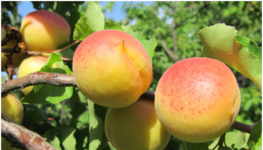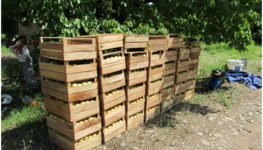08/04/13
Support for the Establishment of Apricot Collection Orchards for the Purpose of Genetic Fund Preservation
08/04/2013: Fruit production has previously been the most profitable element of the cropping pattern in Armenia. The range in altitude of the country and variety of soil-climatic conditions have created conditions for the production of apricot, peach, plum, cherry, apple, pear, quince, walnut, peanut, fig and pomegranate. Of the total orchard areas of 34,780 ha, apricot and peach makes 78-80%.
Apricot has its own important place among other fruit varieties grown in Armenia.
As result of numerous research works it appears that even 6-8 thousand years ago apricot trees were growing on the territory of Armenia.
In Armenia apricot trees are growing and bearing fruits very well at 600-1800 meters and even up to 2000 meters above sea level.
During recent years Armenian apricots are becoming an important product not only for the internal market but also for the external market (Russian Federation, other CIS countries and in the future to EU countries).

Taking advantage of existing and potential trade opportunities and favorable climate conditions in Armenia to produce different variety of apricots and to expand apricot growing geographically, to extend apricot maturing season (when used fresh) and to increase export volumes, the government of Armenia decided to request FAO technical assistance to start rehabilitation of apricot production in the country.
The outcome of the project is: availability and proper management of genetic resources for a solid apricot industry.
Outputs of the project are the following: a) establishment of apricot collection orchards for the purpose of genetic fund preservation. b) establishment of foundation mother orchards with the aim to provide assistance to organizations and individuals involved in apricot planting materials growing, and c) establishment of demonstration orchards in different zones by establishing intensive orchards, using dwarf root stocks and modern technologies in apricot growing, and provision of adequate trainings in improved apricot production to the farmers to increase production levels.
It is expected that the project will reach a broad range of beneficiaries, divided into targeted and final beneficiary groups.
Varieties

Apricot in Armenia is represented by many types and varieties. From fruiting point of view the known local varieties are not separated ones but are fairly diverse populations, which are named variety groups. Retaining peculiarities that are specific for the same group in general, they differ in trees, leaves, flowers, size, color, quality, maturing time and other peculiarities.
Based on shape, biological and production specifications as well as growing areas, Armenian apricots are categorized in 10 variety groups. 50 varieties are mentioned.
Since apricot production is one of the major directions of fruit production in the Republic of Armenia and since Armenian apricot is considered a brand product in both internal and foreign markets, the Government attaches high importance to this Project. The Project is aimed at creating suitable preconditions for the preservation of apricot genetic resources and, especially, their use for selection purposes. Of the 40 varieties currently zoned in the Republic of Armenia, three occupy about 98%. In this regard the Government policy includes provisions on diversification and geographical expansion of the apricot production which would allow both adding farmer incomes and reducing poverty.
In addition, on November 30, 2006, the Government of the Republic of Armenia adopted Decision No. 1826 on the "Strategy for Sustainable Agriculture Development in Armenia."
One of the directions was to provide assistance in the preservation of the wild varieties. One option for this purpose is the creation of a genetic bank of traditional wild varieties. Nursery development measures were mentioned as one of the activities ensuring the implementation of the strategic plan.
The goal is the production of high quality and high value variety cuttings which will, in turn, enable the establishment of pure varieties, as well as valuable and high yield apricot orchards.
The climatic conditions of the country are favorable for other apricot varieties as well. That will make possible to expand apricot growing geography, extend apricot maturing season (when used fresh) and increase export volumes.
Apricot genetic resources
Armenia is considered as one of the centers of emergence of crops. This is evidenced by the fact that the age of ethno-botanic materials goes back to the eighth millennium B.C. According to archaeological studies, Armenia has been home for cereals, vegetables, melons, and essential oil plants, as well as for numerous types of fruit trees (apricot, grape, quince, pomegranate, etc.).
Because Armenia still preserves the wild species of the mentioned cultivars and centralizes the large amounts of these plants, the country is considered to be one of the world's centers of origin of many cultivated crops.

Armenia's biodiversity is presented in groups of fruits, cereals, legumes, fodders, vegetable and melon crops, and oil-bearing crops.
Currently the significance of maintenance of genetic resources of plants used in food production and agriculture is growing to become one of the critical components of the agricultural and environmental policy.
Apricot's genetic resources are valuable starting materials in crop breeding promoting the economic growth, national autonomy and food security, simultaneously playing an important role in maintenance of the environmental balance.
It is a common knowledge that the wild relatives of the crops and particularly for the apricot and the original local varieties bear in their genotype stable genes resistant to different diseases, pests, frost and drought. Not only the efficient use of genetic resources has an exceptional importance, but also it is inevitable in receiving new hybrids and varieties in terms of enhanced capability adapting to the environment.
For the genetic resources of apricots consisting of modern cultivated varieties, original local varieties, wild relatives and hybrids and breeding lines used as starting material maintenance is of essential significance.
So far even during Soviet times a collection orchard of apricot was founded in the Scientific Research Institute on "Viticulture, wine making and fruit growing" in Merdzavan. Around 5055 types and varieties were gathered there. But because of the economic crisis in 1990 the mentioned orchard was destroyed and later the location was privatized by the population of the community.
At present the majority of these varieties and types are on the edge of disappearing and establishment of collection orchard will make it possible to retain these varieties.
At the beginning of the 1990s, due to the high volume of land privatizations, orchard partitions and destructions, cedar forests suffered significantly and orchards, where different varieties were growing, disappeared. Therefore, the preservation of the genetic resources of apricot has become highly urgent because 90% of more than 3 dozen varieties subjected to zoning in Armenia are under the threat of extinction, whereas the genetic qualities of those varieties need to be used both for selection and orchard planting purposes at relatively elevated (highland) zones.
Armenian apricot is a brand and the preservation and use of its genetic resources through the creation of a collection orchard is extremely important for its development.

The project will contribute to the sustainable development of agriculture in the country through establishing the basis for the improvement and modernization of the apricot production sector with possible future significant output to food security, employment opportunities and income generation.
The main outputs contributing to the sustainability of the project will be the establishment of apricot collection orchards for genetic fund preservation; the establishment of foundation mother orchards and the establishment of demonstration orchards in different zones.
At the end of the project, the Government will ensure the continuation of the activities which have been initiated by the project. The project team of trained experts will be in a position to continue the maintenance of the above mentioned orchards. In this context, funds to support the activities related to the maintenance would be assured by the Government. The government has approved a long-term program for orchards development with a total budget of 54 million USD and within this program the government will provide financial resources to the extension services and for the research.
The project will be instrumental in promoting the adoption of integrated practices for orchard establishment and management as well as pest management, soil and water management. The involvement of technical, extension and research staff in the various capacity building activities in the demonstration farms will provide for a sound knowledge base of the key actors.
Submitted by: Ani Grigoryan
Project: TCP/ARM/3302
